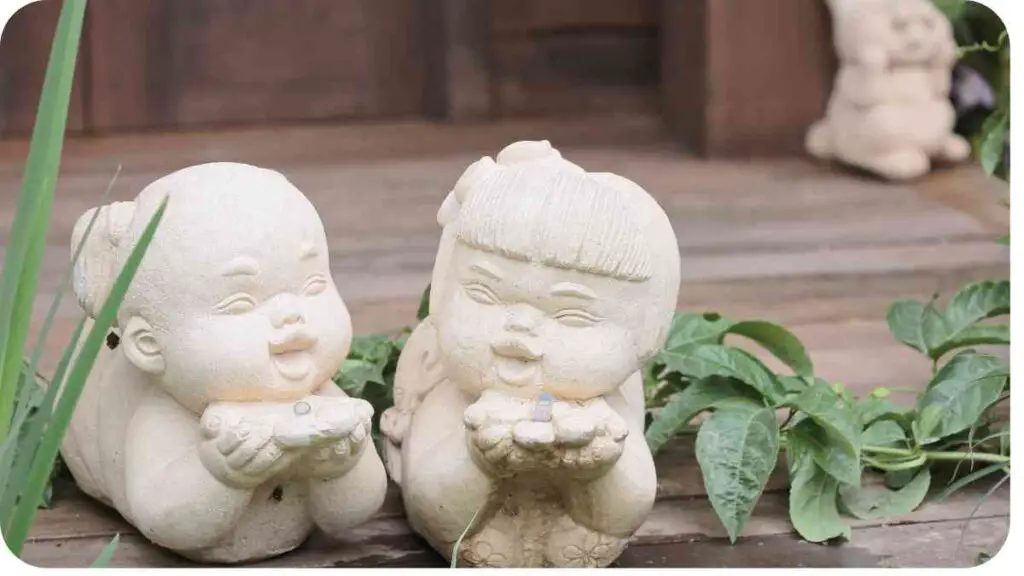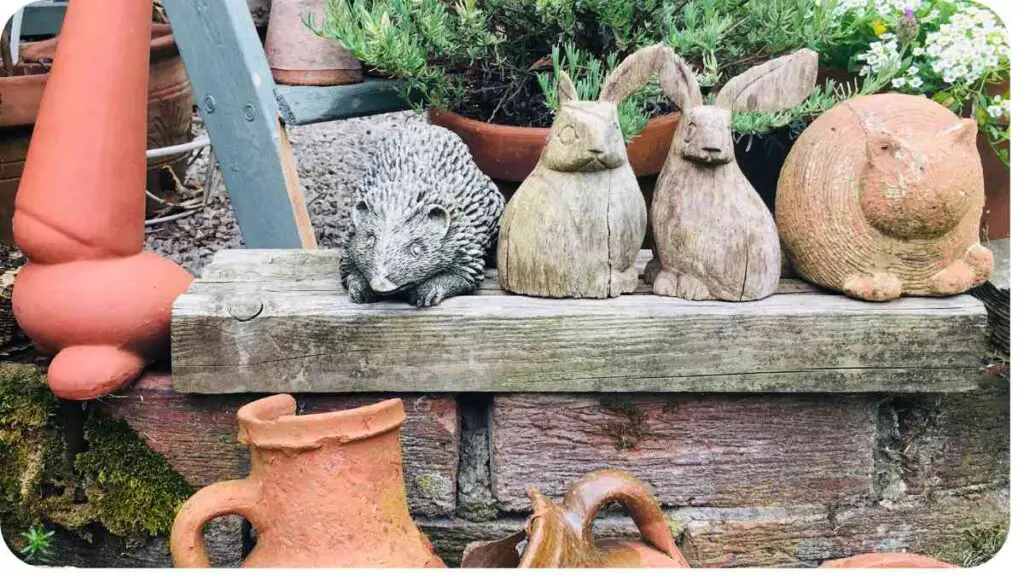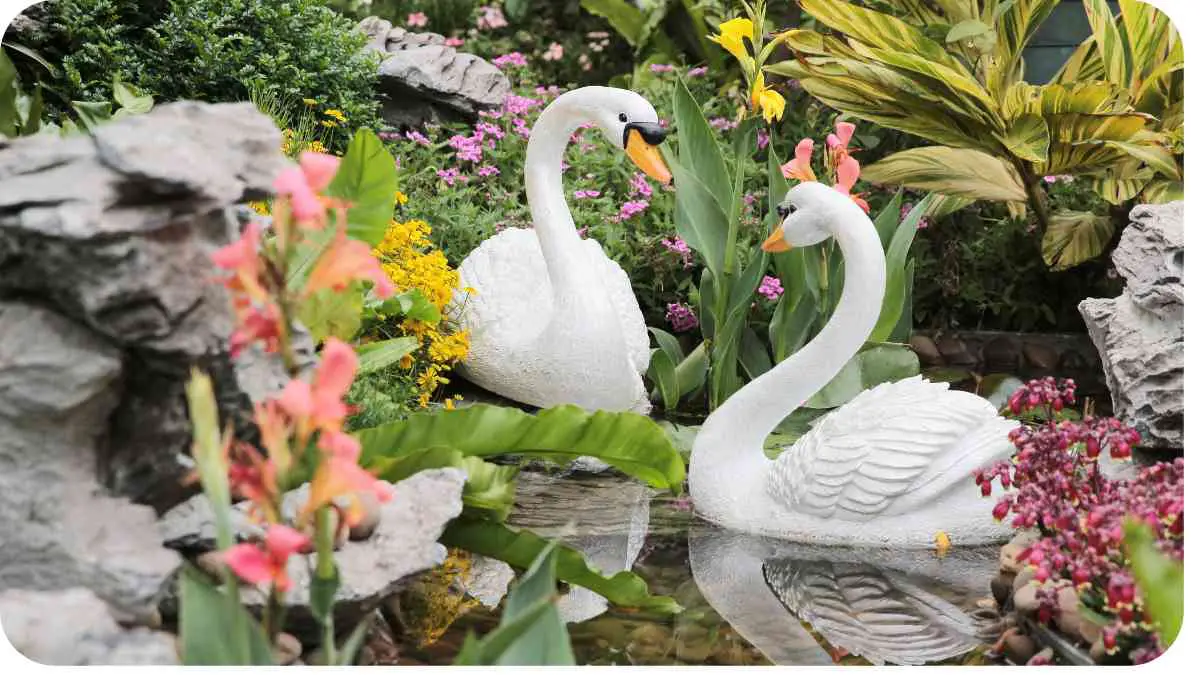Garden ornaments add charm and personality to outdoor spaces, but over time, their vibrant colors can fade, leaving them looking tired and dull. However, with the right techniques, you can breathe new life into your faded garden ornaments and restore them to their former glory.
In this comprehensive guide, we’ll explore the causes of fading, how to assess the damage, choose the right restoration method, and provide step-by-step instructions for bringing back the color to your beloved garden decor.
| Takeaways |
|---|
| 1. Understand the causes of fading in garden ornaments, including UV exposure, weather conditions, and poor quality materials. |
| 2. Assess the damage to your garden ornaments using a color fading severity scale and signs of damage such as cracks and peeling. |
| 3. Choose the right restoration method, whether it’s painting, staining, or sealing, based on the type of material and extent of damage. |
| 4. Properly prepare the surface of your garden ornaments by cleaning and sanding before applying any new finish. |
| 5. Implement regular maintenance techniques to prevent future fading, including cleaning, applying sealant, and providing shelter during harsh weather conditions. |
| 6. Consider seeking professional assistance for complex restoration projects or if you’re unsure about how to properly restore your garden ornaments. |
2. Understanding Fading in Garden Ornaments

Before diving into restoration techniques, it’s essential to understand why garden ornaments fade in the first place. Fading occurs when the pigments in the paint or stain break down due to exposure to various environmental factors such as UV radiation, weather conditions, and the quality of materials used.
To instantly enhance your garden’s aesthetic appeal, explore various techniques such as adding vibrant flowers and colorful garden accessories. For comprehensive tips on achieving this, check out our guide on how to add instant colour to a garden. These methods can significantly uplift the look of your outdoor space.
Causes of Fading
UV Exposure
Exposure to sunlight is one of the primary reasons for color fading in garden ornaments. UV radiation breaks down the molecular structure of pigments, causing them to lose their vibrancy over time.
| UV Exposure Level | Fading Severity |
|---|---|
| Low | Minimal |
| Moderate | Noticeable |
| High | Significant |
Weather Conditions
Extreme weather conditions, including rain, snow, and fluctuating temperatures, can accelerate the fading process. Moisture and temperature fluctuations cause expansion and contraction, leading to cracks in the paint or stain, which allows UV rays to penetrate more easily.
| Weather Condition | Effect on Fading |
|---|---|
| Rain | Accelerates |
| Snow | Accelerates |
| Temperature Fluctuations | Accelerates |
Poor Quality Materials
The quality of the paint, stain, or sealant used on garden ornaments also plays a significant role in their longevity. Inferior quality materials are more susceptible to fading and deterioration, especially when exposed to harsh environmental conditions.
Assessing the Damage
Before beginning the restoration process, it’s crucial to assess the extent of the damage to your garden ornaments. This will help you determine the best course of action and the level of restoration required.
If your outdoor wooden furniture has seen better days, you can restore it to its former glory with a few simple steps. Our detailed guide on restoring weathered wooden outdoor furniture provides essential tips to rejuvenate your garden pieces, ensuring they look as good as new.
Color Fading Severity Scale
To assess the severity of color fading, you can use a simple scale ranging from minimal to significant. Observe the overall color intensity and any areas where the pigment has completely faded or turned white.
Signs of Damage
In addition to faded colors, there are other signs of damage to look out for, including:
- Cracks and Peeling: Check for cracks or peeling paint/stain, which indicate that the surface has been compromised and requires immediate attention.
- Chalky Residue: A chalky residue on the surface of the ornament is a sign of pigment breakdown and indicates that the protective layer has worn off.
- Discoloration: Look for areas of discoloration or uneven fading, which may indicate localized damage.
By thoroughly assessing the damage, you’ll be better equipped to choose the most appropriate restoration method and achieve optimal results.
Preparing for Restoration
Once you’ve assessed the damage, the next step is to prepare your garden ornaments for restoration. Proper preparation is essential for ensuring that the restoration process is successful and that the new finish adheres properly to the surface.
Preparing for Restoration

Preparing your garden ornaments for restoration is a crucial step that can significantly impact the outcome of the project. Proper preparation ensures that the surface is clean, smooth, and free from any contaminants, allowing the new finish to adhere properly and last longer.
Cleaning
Before applying any new paint, stain, or sealant, it’s essential to thoroughly clean the surface of your garden ornaments to remove dirt, grime, and any existing coatings. Use a mild detergent or specialized cleaner formulated for outdoor surfaces and scrub the ornament gently with a soft-bristle brush or sponge.
Surface Preparation
After cleaning, it’s time to prepare the surface for restoration. This may involve sanding down rough or uneven areas, filling in any cracks or holes with wood filler or epoxy, and smoothing out any imperfections. A smooth and properly prepared surface will ensure that the new finish goes on evenly and adheres well.
Proper maintenance of your garden tools is crucial for their longevity and functionality. Learn how to tackle common issues like rust with our repairing rusty outdoor tools article. Keeping your tools in top condition will help you maintain a beautiful and efficient garden.
Table: Recommended Cleaning and Surface Preparation Supplies
| Supplies | Description |
|---|---|
| Mild Detergent | Gentle cleanser suitable for outdoor surfaces |
| Soft-bristle Brush | For scrubbing away dirt and grime |
| Sandpaper | Various grits for sanding down rough areas |
| Wood Filler/Epoxy | For filling in cracks, holes, and imperfections |
| Putty Knife | To apply wood filler or epoxy |
| Tack Cloth | For removing dust and debris before painting/staining |
| Painter’s Tape | To protect surrounding areas from overspray |
By investing time in proper cleaning and surface preparation, you’ll ensure that your garden ornaments are ready to receive a fresh coat of paint, stain, or sealant, resulting in a professional-looking finish that will withstand the elements for years to come.
Step-by-Step Restoration Process
Restoring faded garden ornaments requires careful attention to detail and a systematic approach. Follow these step-by-step instructions to bring back the color and vitality to your beloved outdoor decor.
Supplies Needed
Before you begin the restoration process, gather all the necessary supplies:
- Paint or Stain: Choose a high-quality outdoor paint or stain in the desired color.
- Primer (if needed): Use a primer formulated for outdoor use to ensure proper adhesion.
- Sealant: Select a clear, weather-resistant sealant to protect the new finish.
- Paintbrushes or Rollers: Depending on the size and intricacy of the ornament, choose appropriate brushes or rollers.
- Sandpaper: Various grits for sanding down rough areas and smoothing out imperfections.
- Protective Gear: Wear gloves, safety goggles, and a mask to protect yourself from fumes and debris.
- Drop Cloth: To protect the surrounding area from drips and spills.
Painting Technique
If you’re painting your garden ornaments, follow these steps:
- Prepare the Surface: Ensure that the surface is clean, dry, and free from any contaminants. Sand down rough areas and remove any loose paint or debris.
- Apply Primer (if needed): If the surface is bare or has been previously painted, apply a primer to ensure proper adhesion of the new paint.
- Apply Paint: Using a paintbrush or roller, apply the paint evenly in thin coats, allowing each coat to dry completely before applying the next one. For intricate details, use a smaller brush for precision.
- Allow to Dry: Once you’ve achieved the desired coverage, allow the paint to dry thoroughly according to the manufacturer’s instructions.
- Apply Sealant: Once the paint is completely dry, apply a clear, weather-resistant sealant to protect the new finish from the elements.
Staining Technique
If you prefer to stain your garden ornaments, follow these steps:
- Prepare the Surface: Clean the surface thoroughly and sand down rough areas to ensure a smooth finish.
- Apply Stain: Using a brush or cloth, apply the stain evenly in the direction of the wood grain. Allow the stain to penetrate the surface for a few minutes, then wipe off any excess with a clean cloth.
- Repeat if Necessary: For deeper color saturation, apply additional coats of stain, allowing each coat to dry completely before applying the next one.
- Allow to Dry: Once you’ve achieved the desired color, allow the stain to dry thoroughly according to the manufacturer’s instructions.
- Apply Sealant: Finish by applying a clear, weather-resistant sealant to protect the stained surface from moisture and UV damage.
Sealing Technique
Whether you’ve painted or stained your garden ornaments, sealing is an essential final step to ensure long-lasting protection:
- Ensure Surface is Dry: Make sure the surface is completely dry before applying the sealant to avoid trapping moisture.
- Apply Sealant: Using a brush or sprayer, apply the sealant evenly over the entire surface of the ornament. Pay special attention to any intricate details or crevices.
- Allow to Cure: Allow the sealant to cure completely according to the manufacturer’s instructions before placing the ornament back in your garden.
Ensuring the stability of garden structures is vital for both safety and aesthetics. If you need advice on fixing various garden elements, our guide on fixing wobbly garden structures offers practical solutions to keep your pergolas, arbors, and other structures secure and attractive.
Maintenance Tips to Prevent Future Fading

After investing time and effort into restoring your garden ornaments, it’s essential to take proactive measures to preserve their newfound vibrancy and protect them from future fading. Here are some maintenance tips to help you prolong the lifespan of your outdoor decor:
- Choose Quality Materials: When purchasing new garden ornaments, opt for those made from durable materials that are designed to withstand outdoor elements. High-quality materials are less likely to fade or deteriorate quickly.
- Apply UV-Resistant Sealant: Before placing your garden ornaments outdoors, apply a UV-resistant sealant to provide an additional layer of protection against the harmful effects of sunlight. Reapply the sealant periodically to maintain its effectiveness.
- Regular Cleaning: Keep your garden ornaments clean by regularly removing dirt, dust, and debris. Use a mild detergent and water to gently clean the surface, taking care not to scrub too harshly, which can damage the finish.
- Avoid Harsh Chemicals: When cleaning your garden ornaments, avoid using harsh chemicals or abrasive cleaners, as these can strip away the protective coating and accelerate fading. Opt for gentle cleaning solutions that are safe for outdoor use.
- Provide Shelter: If possible, place your garden ornaments in a sheltered area away from direct sunlight and extreme weather conditions. This can help reduce exposure to UV rays and prolong the life of the finish.
- Touch-Up as Needed: Keep an eye out for any signs of fading or damage, and touch up the finish as needed to maintain its appearance. Use the same paint or stain used during the restoration process for seamless results.
- Seasonal Inspections: Conduct regular inspections of your garden ornaments at the beginning and end of each season. Look for any signs of wear or damage, such as cracks, peeling, or discoloration, and address them promptly.
- Store During Harsh Weather: During periods of extreme weather, such as heavy rain or snow, consider temporarily removing your garden ornaments and storing them indoors or in a covered area to protect them from damage.
- Rotate Placement: Rotate the placement of your garden ornaments periodically to ensure even exposure to sunlight and weather conditions. This can help prevent uneven fading and prolong the life of the finish.
- Professional Maintenance: If you’re unsure about how to properly maintain your garden ornaments or if they require specialized care, consider seeking professional maintenance services from a qualified contractor or restoration specialist.
Moss and algae can detract from the beauty of your garden and cause damage if left unchecked. For effective strategies to manage this issue, refer to our article on dealing with moss and algae growth. These tips will help you maintain a healthy and visually appealing garden environment.
Conclusion
Restoring color to faded garden ornaments is a rewarding endeavor that can breathe new life into your outdoor space. By understanding the causes of fading, choosing the right restoration method, and implementing proper maintenance techniques, you can preserve the beauty and longevity of your beloved outdoor decor.
Whether you opt for painting, staining, or sealing, the key is to use high-quality materials and follow a systematic approach to achieve professional-looking results. By investing time and effort into restoring and maintaining your garden ornaments, you can create an inviting and vibrant outdoor oasis that you can enjoy for years to come.
Remember to regularly inspect and clean your garden ornaments, provide shelter during harsh weather conditions, and touch up the finish as needed to prevent future fading. By taking proactive measures to protect your outdoor decor, you can ensure that it remains a focal point of beauty and inspiration in your garden.
Incorporate these tips into your gardening routine, and watch as your faded garden ornaments transform into stunning focal points that enhance the charm and personality of your outdoor space.
Thank you for joining us on this journey to restore color to faded garden ornaments. We hope you found this guide helpful and inspiring as you embark on your own restoration projects.
Happy gardening!
Further Reading
- How to Restore Faded Plastic Garden Furniture: This comprehensive guide offers step-by-step instructions for restoring faded plastic garden furniture using common household products.
- How to Refresh Metal Garden Decor: Learn how to breathe new life into your metal garden decor with this helpful tutorial, including tips for cleaning, painting, and protecting metal surfaces.
- How to Locate Materials to Repaint Faded Resin Blue-Green Statues: Discover where to find materials and resources for repainting faded resin blue-green statues, along with expert advice from the DIY community on HomeTalk.
FAQs
How can I prevent fading in my garden ornaments?
Regular maintenance, such as cleaning and applying a UV-resistant sealant, can help prevent fading caused by exposure to sunlight and weather conditions.
Can I repaint my faded garden ornaments?
Yes, you can repaint faded garden ornaments using outdoor paint or stain. Make sure to properly prepare the surface and choose high-quality materials for long-lasting results.
What should I do if my garden ornaments have cracks or peeling paint?
Address any cracks or peeling paint by sanding down the surface, filling in the imperfections with wood filler or epoxy, and then applying a fresh coat of paint or stain.
How often should I inspect my garden ornaments for damage?
It’s a good idea to inspect your garden ornaments for damage at least twice a year, preferably at the beginning and end of each gardening season, to catch any issues early and address them promptly.
Can I hire a professional to restore my garden ornaments?
Yes, if you’re unsure about how to properly restore your garden ornaments or if they require specialized care, consider hiring a professional contractor or restoration specialist for expert assistance.

Hi! My name is Hellen James, and I’m here to help you with your home-maintenance needs. Whether it’s building a better yard or just trying to fix a garden—I can show you how.


